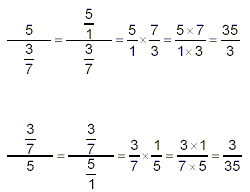Simplifying Complex Fractions
Complex fractions are fractions whose numerator and
denominator themselves contain fractions. The goal of simplifying
a complex fraction is to rewrite it as an equivalent fraction in
which the numerator and denominator do not contain any other
fractions. When we’re considering numerical fractions, this
means that the numerator and the denominator of the final form
are each just single numbers.
The most effective procedure consists of several steps
involving the operations we have already
1. simplify the expression in the numerator of the complex
fraction to a single fraction in simplest form
2. simplify the expression in the denominator of the complex
fraction to a single fraction in simplest form
3. the original complex fraction now looks like one fraction
divided by another fraction. Carry out the division and simplify
the result.
Example: Simplify  . .
solution: This is a complex fraction because the numerator is
a sum of two fractions and the denominator is a difference of two
fractions. You might be tempted to immediately do some
cancellations (since, for example, the numerator and denominator
both contain  , etc.), but none of the common “things” in
any of the fractions present are factors of either the numerator
or the denominator, and so cancellations to attempt to simplify
things here would be an error. Instead, we follow the systematic
approach described above. , etc.), but none of the common “things” in
any of the fractions present are factors of either the numerator
or the denominator, and so cancellations to attempt to simplify
things here would be an error. Instead, we follow the systematic
approach described above.
(1) simplify the expression in the numerator of the complex
fraction to a single fraction in simplest form

(2) simplify the expression in the denominator of the complex
fraction to a single fraction in

(3) now:

This last sequence includes whatever simplification appears
possible. Thus, the final answer is

Example: Simplify 
solution: In steps

So

as the final answer.
The method described here also covers the case where either a
whole number is divided by a fraction, or a fraction is divided
by a whole number.
Examples:

You can see that the general rule for this kind of problem is:

When a fraction is divided by a whole number, you just
multiply that whole number into the denominator of the fraction.
|